
In the week of the announcement of Katalin Karikó's Nobel Prize in Physiology or Medicine, the memoir "Breaking Through - My Life in Science" was published in Hungarian. Since then, several book reviews have been published. By summarizing what happened since then we will direct the attention to those who contributed to the success of Breaking Through.
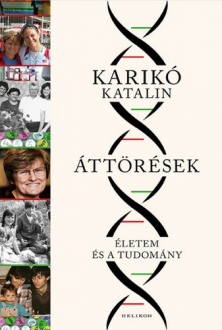
Visitors to the 28th Budapest International Book Festival — which was held between September 28 and October 1, 2023 — were the first to get their hands on the Hungarian version of Katalin Karikó's book: Breaking Through – My Life in Science.
The memoir hit bookstores in Hungary on October 4, 2023, and the English version in the United States on October 10. Breaking Through was in second place in the October bestseller list of the largest Hungarian online bookstore. Who contributed to the exceptional success of the book?
Cover photo in women's magazine
"How did you come up with the idea?" Katalin Karikó got this question from the women's magazine Nők Lapja about her autobiographical book, published both in America and Hungary. "Many people contacted me to write my life story, which I didn't know what to do with for a while. I said to my daughter, Zsuzsi: 'You speak both Hungarian and English well, you can write, you know my life, what if you did it?' She, on the other hand, suggested that we look for an agency where they would help us write, edit, publish, and distribute the book" Katalin Karikó revealed how the memoir was born.
Éva Akovács, the editor-in-chief of the Nők Lapja Magazine celebrating its 74th anniversary this year, admitted in an editorial: that they had just sent the cover referring to the birthday of the magazine to print, when "the news arrived: a Hungarian woman researcher won the Nobel Prize! Everyone stopped working for a moment, and we were just happy for Katalin Karikó's well-deserved recognition. Then the machinery started, phone calls, e-mails, and the new front page was ready."
At the request of Helikon Publishing House, Emese Dudics did the interview for Nők Lapja Magazine. We connected the publisher's press officer, András Pál, with István Sahin-Tóth, a photo reporter of the University of Szeged, with whom we selected the perfect cover photo from the portraits of Katalin Karikó previously taken. These photographs, along with a photo from the family archive, illustrated the cover story of the famous Hungarian magazine.
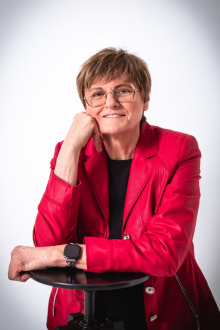
The Hungarian book launch was a world premiere
The women's magazine hit the stands on October 11, 2023, with the headline "Exclusive interview - Katalin Karikó, the first Hungarian woman to win the Nobel Prize". Coincidentally, it happened on this very day that Helikon Publishing held the first Hungarian book launch of Karikó's memoir. The invitation to the headquarters of the Hungarian Academy of Sciences (MTA) quoted the recommendation of Bill Gates: "The story of Katalin Karikó has an inspiring power. A must-read for anyone who has ever doubted that science, innovation, and determination can change the world."
For October 11, 2023, Helikon stamped the book cover of Breaking Through with the label "NOBEL PRIZE 2023 in Medicine". "From the autobiography of the world-famous Hungarian researcher, we can learn how the journey of a girl from Kisújszállás led from the Hungary of the Kádár era to the forefront of the most important scientists shaping the fate of humanity," read the program reviewer. Katalin Karikó was asked about the details by János Horvát, a well-known TV reporter.
The reporter, who introduced himself as a friend of the Karikó family, also emphasized: that the Hungarian book launch of Breaking Through was a world premiere. One of the reasons for this is that the promotion of Breaking Through fell during the stay of the author of the book — originally written in English — in Hungary.
As one of the turning points of the interview, the moderator invited Katalin Karikó's sister, Zsuzsa Karikó, to the podium. The lively conversation can also be viewed on the largest video-sharing portal here.
Book signing at the Karikó days in Szeged
The first book of the first female Hungarian Nobel laureate was reported on by almost every Hungarian media outlet — from blikk.hu to kultúra.hu and origo.hu to Qubit.
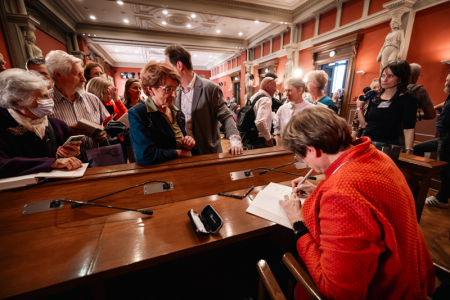
Katalin Karikó signed her newly published memoir to all interested readers after the book launch discussion held at the MTA headquarters. Photo: István Sahin-Tóth
Each media highlighted the elements of Katalin Karikó's fairy-tale-worthy story that correspond to the interests of its perceived or real readership. It is also thanks to the impact of the many articles that Breaking Through started on the path of successful books. As the publicity of the work grew, so did the book signing demand of the audience and future readers.
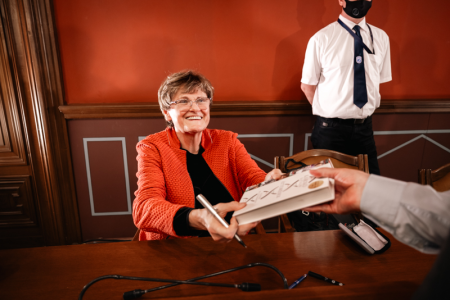
Book signing is the ritual of literary life. Katalin Karikó handed over a signed volume of her book Breaking Through - My Life in Science to more than a hundred readers. Photo: István Sahin-Tóth
Book signing is the ritual of literary life. The author's message and signature on the inside title page of a book are a tribute to the reader. It was an exceptional gesture of the Nobel laureate Katalin Karikó that she signed her book Breaking Through to everyone who asked. After the conversation at the MTA headquarters, she signed her book for an hour and a half.
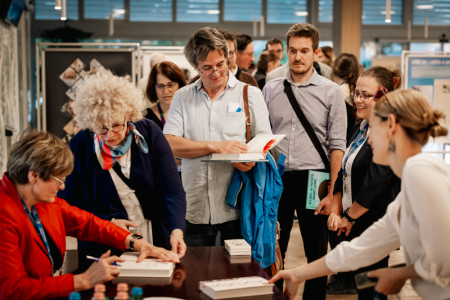
Almost all the employees of the Szeged Biological Research Center (SZBK) signed the autobiographical volume with the Nobel laureate Katalin Karikó, in which the world-famous mRNA researcher also remembers the period she spent at SZBK. Photo: István Sahin-Tóth
The book signing also continued on October 12, 2023, in Szeged in the iconic university building on Dóm Square, in the study "taken over" from Nobel laureate Albert Szent-Györgyi, as well as on October 13 during the 50th-anniversary celebration of the founding of the Szeged Biological Research Institute. Katalin Karikó gave at least eight hundred autographs, according to my estimation. The number of sales of Breaking Through broke records at the "Karikó days" in Szeged.
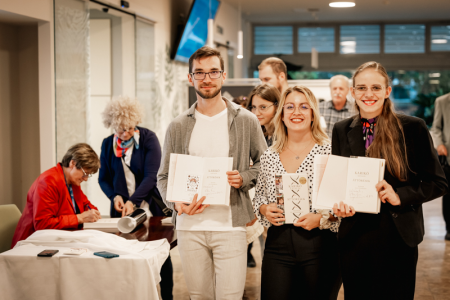
The author's signature and the ex-libris indicating belonging to Katalin Karikó's library further increase the value of the work Breaking Through - My Life in Science. Photo: István Sahin-Tóth
Reviews on the alma mater's social media pages
"From the bench to behind the rows. A weekly book review of works by SZTE authors. Each week we feature a book to look out for," SZTE's Alma Mater review series begins each week. On October 21, 2023, the alumni organization of the University of Szeged posted a review of Karikó's book on the most popular social media site.
"The book breaks with the tradition of average biographical writings, as it does not overflow with dates or dry facts, but introduces its readers to the career path with the help of a life history arc, constantly paralleling the most important stages of her life with the history of her daughter and the mRNA molecule," highlights Anikó Lázárné Csernus, the author of the review series. The book review can be read in English here.
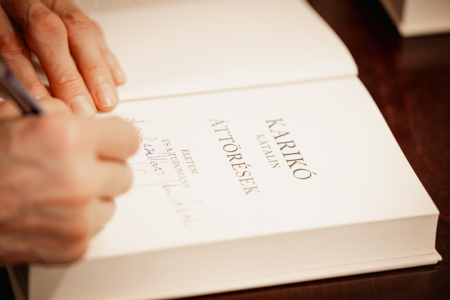
"I say you have to keep going. You have to grow up. Onward, toward the light. You are the opportunity. You are the core," says Katalin Karikó in her memoir.
A review of the memoir Breaking Through - My Life in Science was published on October 31, 2023, on the website of the SZTE Klebelsberg Library. With his book review, the deputy director general, Károly Kokas, in his essay entitled "Katalin Karikó: the path of the scientist's life", undertook to outline how Katalin Karikó reached "from the small-town biology study group to the top of the world".
"Katalin Karikó has a very good sense of capturing those things that can almost be emblematized, those that go beyond themselves and become spectacular metaphors for the given situation," reminds the reviewer. As an example, he mentions some of the lessons of János Selye's stress theory, the figure of Columbo, and the '67 Metro hit Diamond and Gold. "Just like Forrest Gump's aphorisms, these truths of life, which are interestingly always heavily metaphorized, are lovely and very sympathetic."
He makes the same interesting findings about the genre of the book as he does about the standpoint of the author of the memoir. He emphasizes: "this confession is very strongly filled with gratitude".
"Katalin Karikó's work has countless faces, and it will also have readers coming from countless fields of expertise. Young researchers want to discover their destiny and antidotes to unpleasant moments from it, readers interested in gossip columns are looking for the secrets of the Nobel laureate, but there will also be those who want to learn the basics of mRNA and virology from it. It is often said that very complicated things can be explained clearly and simply by those who can 'handle the material' in detail and synthetically, whose knowledge has been created layer by layer. We can experience everything together with the creator, Karikó, by reading the book, we can also be her companions in how the idea, the thought, and the solution itself, with countless twists and turns, were born for the future battles of Covid-virology", explains Károly Kokas.
He points out: "If, after reading, we move away from the details a little and switch to a bird's-eye view, and look at this 300-page book as a whole, we close it with a good feeling. Somehow and with a lucky hand, the form, the way of presentation, and the writing found the appropriate mode for the material. This also means that - especially the dramatic parts with a darker tone - they are often beautifully shaped, one might say on a literary level."
The deputy director general of the university library also writes that "the interested reader can read about Katalin Karikó in many places. But perhaps nowhere can you find such precisely arranged and all-encompassing material as in the well-structured Karikó exhibition and archive of the SZTE Klebelsberg Library, which is constantly developing and expanding." We can add: that the virtual Karikó exhibition, a joint project of the SZTE Directorate for International and Public Relations and the SZTE Klebelsberg Library, also summarizes the echoes of significant press events.
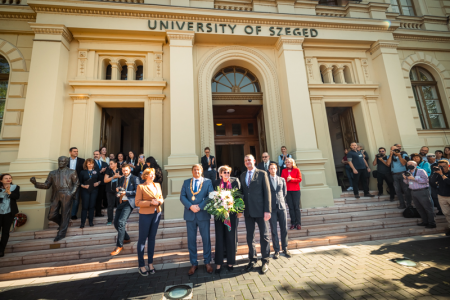
The University of Szeged and the citizens of Szeged welcomed the Nobel laureate Katalin Karikó with a standing ovation and boundless love. Photo: István Sahin-Tóth
Revealing work secrets in the JATE Club
More and more reviews of the book by the first Hungarian Nobel laureate are appearing on the Internet.
For the Szeged book launch of Katalin Karikó's autobiographical book Breaking Through - My Life in Science, those interested were invited to the JATE Club on November 7, 2023. The book could also be purchased on-site before the program, where several of those who helped the publication and promotion of Katalin Karikó's memoir in Hungary were also in the spotlight.
Miklós M. Nagy, the head of Helikon Publishing, achieved that Breaking Through launched in Hungary earlier than in the United States.The book, originally written in English, was translated into Hungarian by associate professor Anna Fenyvesi, head of the Institute of English and American Studies at the SZTE Faculty of Humanities and Social Sciences. The scientific details of the memoir were proofread by Katalin Karikó's former classmate, László Szabados, who graduated from the biology department of the University of Szeged - the former JATE - and works as a scientific advisor at the SZBK Institute of Plant Biology.
The value of the book Breaking Through - My Life in Science is enhanced by the ex libris, which - as a gift from SZTE - was designed for Katalin Karikó by graphic artist Ildikó Biró, assistant professor at the SZTE Juhász Gyula Faculty of Education, Department of Art and Art History.
Katalin Karikó's autobiographical volume published by Helikon Publishing House and the circumstances of the translation and publication were also discussed at the book launch event on November 7 in the JATE Club in Szeged. Ilona Újszászi, SZTE's senior communications expert, moderated the talk with the key figures of the Hungarian version of Breaking Through — the publishing director, the translator, the proofreader, and the graphic artist. The program was part of the 27th Autumn Cultural Festival of the University of Szeged and also connected to the Day of Hungarian Science.
Photos: István Sahin-Tóth

